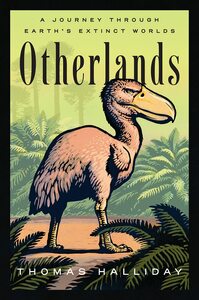Take a photo of a barcode or cover
Though a history buff, for once I am going to go somewhat futuristic here. Not that this book by evolutionary biologist Thomas Halliday (University of Birmingham) predicts the future, on the contrary. But the merit of this book lies mainly in the fact that – by looking at the past – it gives us a better insight into the complexity of the challenges we face today (deterioration of the biosphere, extinction of species, climate change). In this book, Halliday does this by outlining the evolution of life on earth in 16 steps, from about 550 million years ago to 20,000 BP, albeit in reverse order.
Halliday believes in looking at the past to see scenarios for the future: "It is by looking at the past that palaeobiologists, ecologists and climate scientists can address the uncertainty about the near- and long-term future of our planet, casting backwards to predict possible futures." His chapters are regularly full of general reflections on the complexity and evolution of Earth's ecosystems, reflections that are extremely relevant for the future. There is a lot to be learned from past extinctions and collapses in particular: “In the complex game that is an ecosystem, every player is connected to some, but not all, others, a web not just of food but of competition, of who lives where, of light and shade, and of internal disputes within species. Extinction bursts through that web, breaking connections and its threatening integrity. Sever one strand, and it wavers, reshapes, but survives. Tear another, and it will still hold. Over long periods, repairs are made as species adapt, and new balances are reached, new associations made. If enough strands are broken at once, the web will collapse, drifting in the breeze, and the world will have to make do with what little remains. So, after a mass extinction event, a turnover happens, with new species appearing, the web self-repairing.”
Halliday does emphasize that in these processes of extinction and recovery the notion of time, in the sense of long duration (in practice usually millions of years), is extremely relevant. And therefore also in the current climate problem: “The uncertainty is not in the final temperature, only in the time it takes for the atmosphere to adjust, because the feedback systems of the planet’s environment ensure that there is a lag between reaching atmospheric stability and a final temperature plateau. The only way to ensure that we don’t reach these concentrations, and therefore these temperatures, is to reduce carbon emissions at a greater rate than is currently planned.”
Based on his research, the author is remarkably optimistic, albeit with an important warning: “Life recovers, and extinction is followed by diversification. That is, in its way, a comfort, but it is not the whole story. Recovery brings radical change, and often startlingly different worlds, into being, while also taking, at a minimum, tens of thousands of years. Recovery cannot replace what has been lost.” Yet he clearly believes in human agency: “We know what can happen during environmentally turbulent periods like the one in which we live. In mapping the past, we can predict the future, and find the routes that avert disaster. Where some disastrous outcomes are inevitable, we can plan for them, minimize the damage and mitigate them.” And for this, respect for our planet and its biosphere is an absolute condition: “For our long-term well-being as a species and as individuals, we must enter into a more mutualistic relationship with our global environments. Only then can we preserve not just their infinite variety, but also our place within them. Change, eventually, is inevitable, but we can let the planet take its own time, as we allow the shifting sands of geological time to lead us gently into the worlds of tomorrow. Sacrifice, an act of permanence. Then, we too will live in hope.” I'm not sure whether this outlook offers much comfort, but the way Halliday looks at the past to offer benchmarks for the future (and hence also the present) is inspiring, to say the least!
Halliday believes in looking at the past to see scenarios for the future: "It is by looking at the past that palaeobiologists, ecologists and climate scientists can address the uncertainty about the near- and long-term future of our planet, casting backwards to predict possible futures." His chapters are regularly full of general reflections on the complexity and evolution of Earth's ecosystems, reflections that are extremely relevant for the future. There is a lot to be learned from past extinctions and collapses in particular: “In the complex game that is an ecosystem, every player is connected to some, but not all, others, a web not just of food but of competition, of who lives where, of light and shade, and of internal disputes within species. Extinction bursts through that web, breaking connections and its threatening integrity. Sever one strand, and it wavers, reshapes, but survives. Tear another, and it will still hold. Over long periods, repairs are made as species adapt, and new balances are reached, new associations made. If enough strands are broken at once, the web will collapse, drifting in the breeze, and the world will have to make do with what little remains. So, after a mass extinction event, a turnover happens, with new species appearing, the web self-repairing.”
Halliday does emphasize that in these processes of extinction and recovery the notion of time, in the sense of long duration (in practice usually millions of years), is extremely relevant. And therefore also in the current climate problem: “The uncertainty is not in the final temperature, only in the time it takes for the atmosphere to adjust, because the feedback systems of the planet’s environment ensure that there is a lag between reaching atmospheric stability and a final temperature plateau. The only way to ensure that we don’t reach these concentrations, and therefore these temperatures, is to reduce carbon emissions at a greater rate than is currently planned.”
Based on his research, the author is remarkably optimistic, albeit with an important warning: “Life recovers, and extinction is followed by diversification. That is, in its way, a comfort, but it is not the whole story. Recovery brings radical change, and often startlingly different worlds, into being, while also taking, at a minimum, tens of thousands of years. Recovery cannot replace what has been lost.” Yet he clearly believes in human agency: “We know what can happen during environmentally turbulent periods like the one in which we live. In mapping the past, we can predict the future, and find the routes that avert disaster. Where some disastrous outcomes are inevitable, we can plan for them, minimize the damage and mitigate them.” And for this, respect for our planet and its biosphere is an absolute condition: “For our long-term well-being as a species and as individuals, we must enter into a more mutualistic relationship with our global environments. Only then can we preserve not just their infinite variety, but also our place within them. Change, eventually, is inevitable, but we can let the planet take its own time, as we allow the shifting sands of geological time to lead us gently into the worlds of tomorrow. Sacrifice, an act of permanence. Then, we too will live in hope.” I'm not sure whether this outlook offers much comfort, but the way Halliday looks at the past to offer benchmarks for the future (and hence also the present) is inspiring, to say the least!
emotional
informative
reflective
relaxing
sad
medium-paced
I found this surprisingly readable. Halliday is extremely skilled at providing you with mind boggling data in a way that is like being told a story and yet without dumbing anything down at all. This is a journey backwards to the beginning of life on earth. Each chapter takes a different era and geographical place and Halliday creates a fascinating picture of what life on earth would have looked like.
informative
medium-paced
Gaaf boek, dat voorbije werelden tot leven wekt. Wat ik lastig vond is dat hoe verder je terug in de tijd gaat, hoe minder overeenkomsten er zijn met onze tijd - qua soorten, qua layout van de werelddelen. Dat maakt het als leek in de latere hoofdstukken af en toe iets moeilijker om te volgen
informative
inspiring
relaxing
slow-paced
challenging
informative
slow-paced
Don't get me wrong this book was really well researched, well written, and interesting but my goodness it had deserts of dullness that made each oasis of interesting less and less satisfying.
This book takes you through the evolution of plants and animals through geologic time, processes of speciation and epic extinctions. This book took me several weeks to finish. I had to renew it twice and I almost gave up on it but it was a good nighttime read because it definitely got me nice and....relaxed.
Recommend for science teachers and insomniacs.
This book takes you through the evolution of plants and animals through geologic time, processes of speciation and epic extinctions. This book took me several weeks to finish. I had to renew it twice and I almost gave up on it but it was a good nighttime read because it definitely got me nice and....relaxed.
Recommend for science teachers and insomniacs.
informative
inspiring
medium-paced
hopeful
informative
fast-paced
It was a good book, and a good narrator, but it was hard to visualize everything with just the audio. Maybe look at this for a physical read!
Its a very hopeful book too, which is nice in science books.
Its a very hopeful book too, which is nice in science books.
Great non-fiction Book for everyone who is Interested in the history of life and the planet. It feels fresh because it does not focus solely on dinosaurs. Can also really recommend the audiobook.



